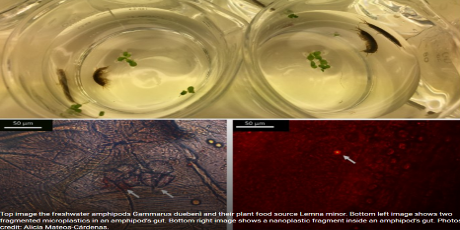UCC/ERI researchers make major, concerning, microplastics discovery 04 Aug 2020

- UCC scientists find small crustacean can fragment microplastics in just four days.
- Findings have significant consequences for the understanding of microplastics in our environment.
- Worrying discovery may have implications for the food chain.
Researchers from University College Cork have discovered that microplastics (plastic pieces smaller than 5 mm) in our freshwaters are being broken down into even smaller nanoplastics (smaller than 1 µm, at least five thousand times smaller in size) by a type of freshwater invertebrate animal, and that this may happen much faster than previously estimated.
Their findings have significant consequences for the understanding of microplastics in our environment and could have implications for the food chain.
Until now, breakdown of plastics had been thought to occur mainly through very slow processes in the marine environment such as sunlight or wave action, which can take years or decades. But UCC researchers have discovered that a very common invertebrate animal found in Irish freshwater streams is able to rapidly breakdown these microplastics in just hours.
Study leader Dr Alicia Mateos-Cárdenas, of UCC’s School of BEES and Environmental Research Institute said:
“We have found that the freshwater amphipod, a small crustacean, called Gammarus duebeni is able to fragment microplastics into different shapes and sizes, including nanoplastics, in less than four days. Whilst this species lives in Irish streams, they belong to a bigger animal group of invertebrates commonly found around the world in freshwaters and oceans. Our finding has substantial consequences for the understanding of the environmental fate of microplastics.”
Microplastics are fragmented by freshwater invertebrate animals as part of their digestive process.
The alarming results of this EPA-funded study, published in Scientific Reports this week, also have consequences in terms of the impacts of plastics. While microplastics can become stuck in the gut of seabirds and fish, current understanding suggests that the smaller nanoplastic particles could penetrate cells and tissues where their effects could be much harder to predict.
The findings that such a common invertebrate animal can rapidly produce vast numbers of nanoplastics is particularly worrying for researchers.
“These invertebrates are very important in ecosystems because they are prey for fish and birds, hence any nanoplastic fragments that they produce may be entering food chains” Dr Alicia Mateos-Cárdenas added.
“The data in this study will help us to understand the role of animals in determining the fate of plastics in our waters, but further research is urgently needed to uncover the full impact of these particles,” she said.
The Open Access study is published today in the journal Scientific Reports. The paper is freely available online HERE
This project was funded under the EPA Research Programme 2014–2020. The EPA Research Programme is a Government of Ireland initiative funded by the Department of Communications, Climate Action and Environment. It is administered by the Environmental Protection Agency, which has the statutory function of co-ordinating and promoting environmental research. This UCC project was supervised by Professor Marcel Jansen, Dr Frank van Pelt and Professor John O’Halloran.